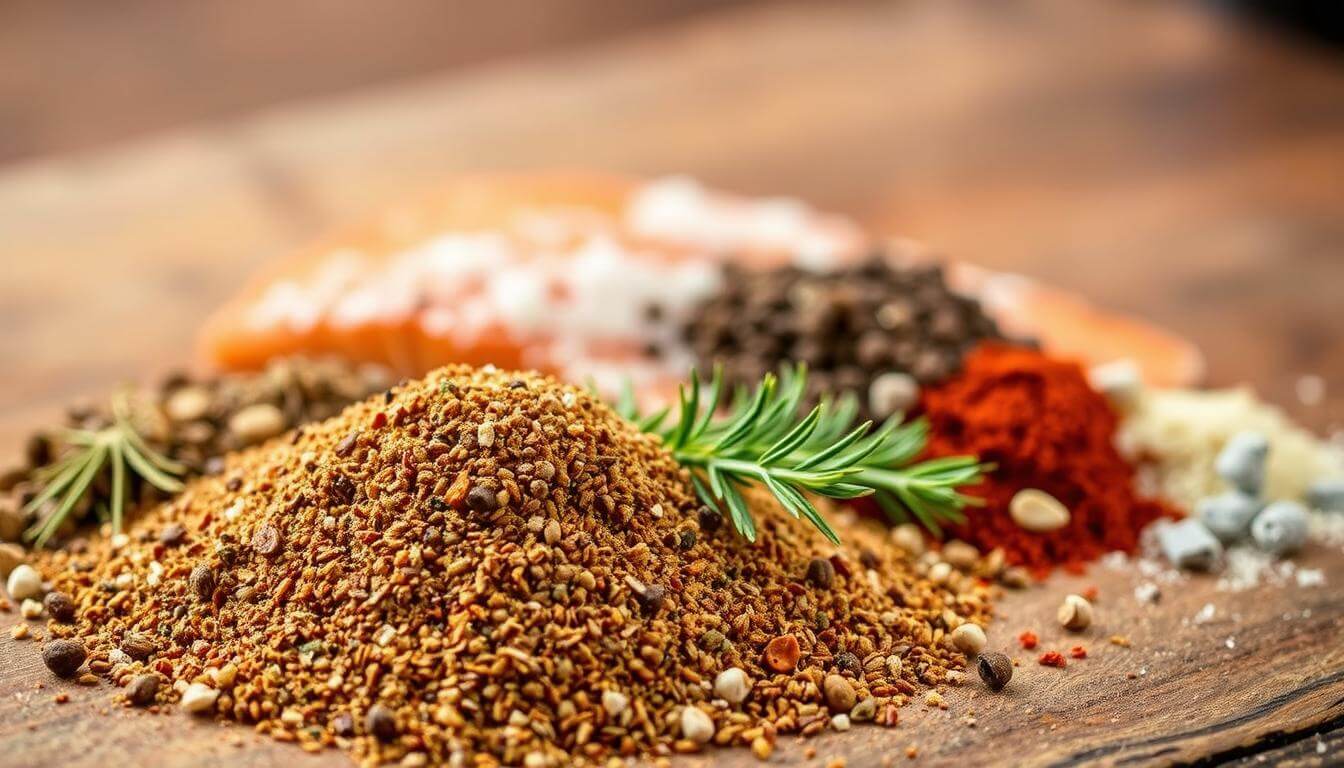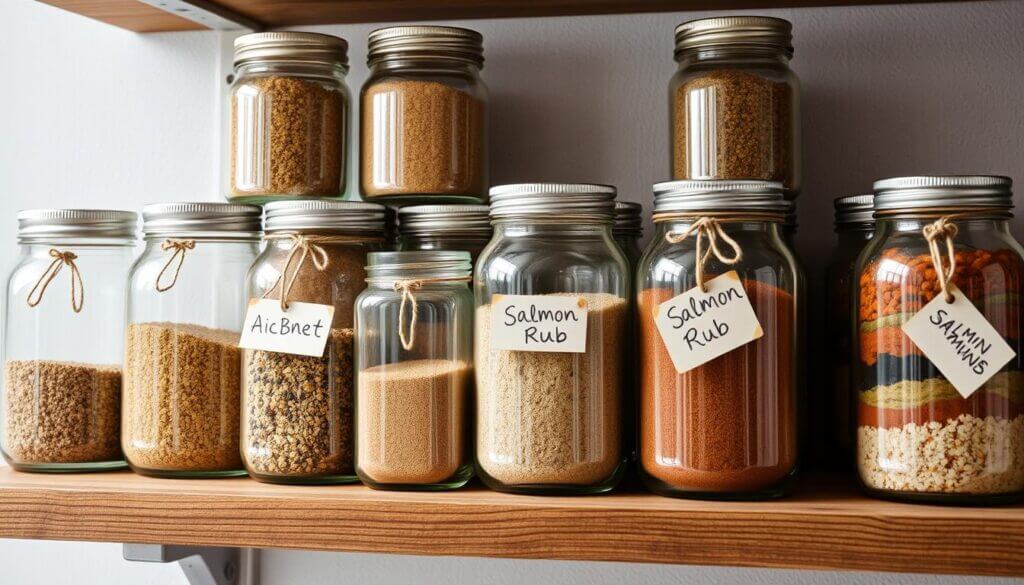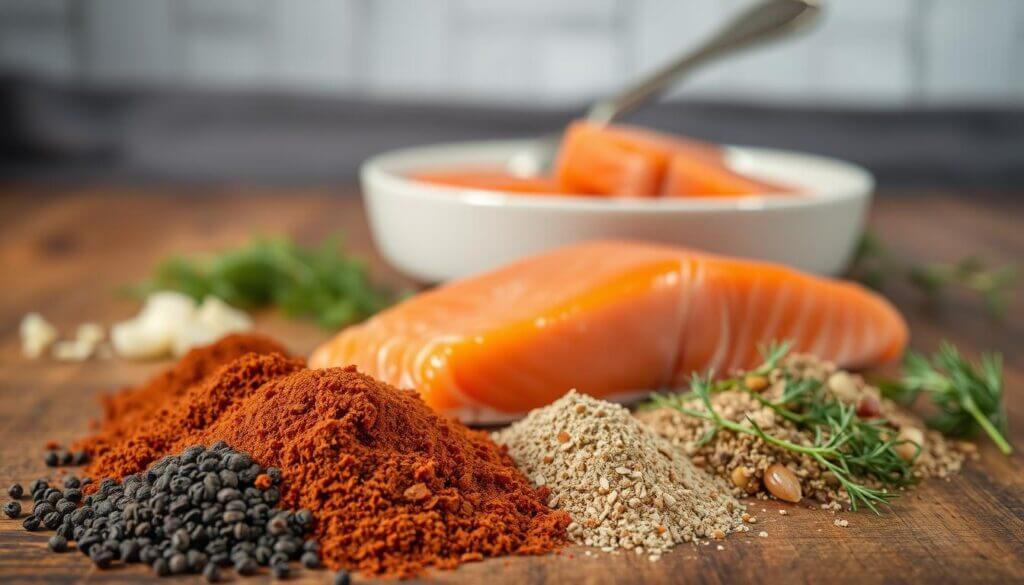How to Make a Delicious dry rub recipe for salmon at Home

Table of Contents
Imagine the first bite of perfectly seasoned salmon. It’s flaky, tender, and full of flavor. Making your own salmon rub recipe is more than just following steps. It’s about creating a taste that’s uniquely yours.
Think of it as your secret to making store-bought fish taste amazing. With ingredients like smoked paprika and brown sugar, you’re creating layers of flavor. These flavors are sweeter, smokier, and more savory than anything you can buy.
Key Takeaways
- Your salmon rub recipe uses just 8-10 simple spices, like garlic powder and thyme, for big flavor.
- Store your homemade rub in a sealed jar for up to 6 months to save time for future meals.
- One serving (1 tsp) has only 8 calories and pairs well with grilling, baking, or air frying.
- Adjust heat with cayenne or swap cumin for less smoke, making it adaptable to any palate.
- Lime zest adds brightness, balancing the rub’s sweetness and saltiness.
Imagine the first bite of perfectly seasoned salmon—flaky, tender, and bursting with flavor. That’s what happens when you use a homemade dry rub. Creating your own salmon rub recipe isn’t just about following steps; it’s about crafting a taste that feels personal. Think of it as your secret to transforming store-bought fish into a dish that stops your family in their tracks. With ingredients like smoked paprika and brown sugar, you’re not just cooking—you’re building layers of sweet, smoky, and savory notes that store-bought options can’t match.
Key Takeaways
- Your salmon rub recipe uses just 8-10 simple spices, like garlic powder and thyme, for big flavor.
- Store your homemade rub in a sealed jar for up to 6 months to save time for future meals.
- One serving (1 tsp) has only 8 calories and pairs well with grilling, baking, or air frying.
- Adjust heat with cayenne or swap cumin for less smoke, making it adaptable to any palate.
- Lime zest adds brightness, balancing the rub’s sweetness and saltiness.
What is a Dry Rub?
A dry rub is a mix of spices and seasonings you put on food before cooking. For salmon, it’s a simple blend of herbs and salt that boosts flavor without extra calories. Think of sprinkling brown sugar, cumin, and paprika on your salmon fillet. That’s your dry rub in action.
Definition and Purpose
Dry rubs make food taste great and keep it moist. They’re simple to make, needing just 7–8 ingredients. For salmon, you might use:
- Brown sugar for sweetness
- Cumin for earthiness
- Paprika for smokiness
Dry rubs don’t need soaking time, making them perfect for quick meals.
Benefits of Using a Dry Rub
Choosing a dry rub for salmon has many benefits:
- Flavor boost: Spices get into the fish, making it taste better without being too strong.
- No added fat or sugar: Unlike batters, dry rubs use only spices.
- Versatile use: Works well on salmon whether you grill, bake, or pan-fry it.
Pro chefs love dry rubs for their flexibility. For example, a mix with smoked paprika and coriander seeds adds depth without extra calories. Plus, you can store leftovers in an airtight jar for easy seasoning later.
| Benefit | Example |
|---|---|
| Time-saving | Mix spices in 2 minutes vs. 30-minute marinating |
| Health-conscious | No added oils or sugar in classic recipes |
Key Ingredients in a Dry Rub for Salmon
Making a great spice rub for salmon recipe is all about mixing the right flavors. Each ingredient adds to the salmon’s taste without taking over. Begin with basic spices for depth, then add your own touches.
Essential Spices and Herbs
These are the key spices for any salmon dry rub:
| Ingredient | Role |
|---|---|
| Smoked Pimentón Paprika | Delivers rich smokiness and mild heat |
| Garlic Powder | Provides savory depth without raw garlic’s pungency |
| Onion Powder | Enhances umami flavor and caramelized sweetness |
| Kosher Salt | Draws moisture and boosts natural flavors |
Optional Flavor Enhancements
Make your spice rub for salmon recipe your own with these extras:
- Cayenne pepper: Adds subtle heat
- Lemon zest: Brightens the blend with citrus
- Mustard powder: Intensifies savory notes
- Coconut sugar: Healthier sweetness alternative
Try different amounts—like more smoked paprika for smokiness or less salt for less sodium. Keep blends in airtight containers for up to six months.
Step-by-Step Guide to Making Your Dry Rub
Creating your salmon rub seasoning recipe starts with precise measurements. Follow these steps to craft a blend that enhances every bite:
Measuring Your Ingredients
Accuracy ensures consistent flavor. Use these exact portions:
| Ingredient | Quantity |
|---|---|
| Brown sugar | 1 cup |
| Smoked paprika | 2 heaping tbsp |
| Dried thyme | 1 tsp |
| Large granule kosher salt | 1 tbsp |
| Pepper | ½ tsp |
Mixing Techniques for Best Results
- Pour all ingredients into a glass jar or bowl.
- Whisk vigorously for 30 seconds until evenly dispersed.
- Use a fork to break up any sugar clumps manually if needed.
- Store in an airtight container after mixing.
Always mix thoroughly to avoid uneven seasoning. This salmon rub seasoning recipe works best when blended until all spices visibly combine.
How to Apply the Dry Rub on Salmon
Before you start, make sure your salmon is ready. Rinse it under cold water and pat it dry with paper towels. Then, lightly score the flesh side with shallow cuts, no deeper than 1/8 inch. This helps the spices get inside evenly without overcooking.
Preparing Your Salmon
- Use a sharp knife to score the flesh side in 1/8-inch deep lines.
- Dab the surface dry to remove excess moisture for better rub adhesion.
- Optional: Brush a thin layer of olive oil over the salmon to help the spices stick.
Even Application Tips
To get the most flavor, spread your smoked salmon rub recipe evenly on both sides. Use your fingers or a spoon to press it into the flesh and skin. Let it sit for 30 minutes to let the flavors mix. Don’t pile the spices too high—go for a light, even layer.
| Step | Action |
|---|---|
| 1 | Apply rub to flesh and skin sides |
| 2 | Massage rub into scored cuts |
| 3 | Rest for 30 minutes before cooking |
Pro tip: Press down firmly on the fillet while cooking skin-side down to prevent curling. Adjust seasoning levels based on your taste—start mild and add more rub next time if desired.
Recommended Dry Rub Recipes for Salmon
Try a classic mix or a sweet and spicy twist. These recipes use key spices to create balanced flavors for seasoning.
Classic Dry Rub Recipe
For a clean, earthy base:
- 1½ Tbsp lightly crushed Wild Ramps
- 1 Tbsp Salina Crystal Salt
- 1 tsp Smoked Pimentón Paprika
- 1 tsp crushed coriander seeds
- ½ tsp Cured Sumac
- ½ tsp Taurus Mountain Thyme
Blend all ingredients and store in an airtight container.
Sweet and Spicy Variation
Balance heat with sugar for depth:
- 2 Tbsp paprika
- ¼ cup chili powder
- 1 Tbsp garlic powder
- 1 tsp salt
- 1 tsp black pepper
- 1 Tbsp brown sugar
- ½ tsp cayenne pepper (adjust to taste)
Combine ingredients, then rub into salmon 30 minutes before cooking. Adjust sugar for desired sweetness.
| Classic | Sweet & Spicy |
|---|---|
| Earthy ramps + smoky paprika | Brown sugar + cayenne heat |
| Stores 3 months | Use within 2 weeks for peak flavor |
Best Cooking Methods for Rubbed Salmon
After you coat your salmon with the salmon seasoning rub recipe, pick the best way to cook it. These methods will make it crispy and tender.
Grilling Salmon with Dry Rub
For smoky results:
- Preheat grill to high heat (450°F) and let it warm for 15 minutes.
- Brush grates with oil to prevent sticking.
- Place salmon skin-side up. Cook flesh side down first for 4–5 minutes.
- Flip carefully, cook 2–3 more minutes until internal temp reaches 125°F. Rest 5 minutes.
Baking Salmon with Dry Rub
Perfect for indoor cooking:
- Preheat oven to 400°F. Line a baking sheet with foil.
- Arrange salmon skin-side down. Brush lightly with oil if desired.
- Bake 12 minutes. Broil for 2 minutes for crispy texture.
- Check internal temp reaches 145°F. Let rest 5 minutes.
Pro tip: Avoid flipping during baking to keep the rub intact.
Pairing Side Dishes with Dry Rubbed Salmon
Once your dry rub recipe for salmon is just right, add sides that make the meal pop. Try fresh salads and hearty grains to bring out the smoky taste of your salmon rub seasoning recipe. This creates a balanced and tasty plate.
Fresh Salads to Complement Your Salmon
- Cucumber Radish Salad: It’s bright, crunchy, and tangy, perfect for balancing rich salmon.
- Blackberry Farm’s Zucchini Caesar Salad: The crispy cheese crisps add texture, and the lemon complements the rub’s citrus notes.
- Tahini Roasted Broccoli: The nutty tahini pairs well with smoky salmon flavors.
Ideal Grain Sides
| Side | Description | Pairing Reason |
|---|---|---|
| Risotto with Peas | Creamy and slightly sweet | Softens bold rub flavors |
| Quinoa and Kale Salad | Nutty quinoa with lemony greens | Light yet hearty |
| Air-Fryer Sweet Potato Fries | Crispy and lightly sweet | Matches the caramelized edges of grilled salmon |
Try roasted veggies like grace young’s stir-fried iceberg lettuce for a crisp contrast. Or, go for shaved brussels sprouts with lemon for a tangy kick. Experiment to find the perfect match for your salmon rub seasoning recipe.
Storing and Keeping Your Dry Rub

Keeping your spice rub for salmon recipe fresh is easy. Just follow these steps to keep it flavorful and safe for months.
How to Store Leftover Dry Rub
- Put the salmon rub recipe in an airtight container like a mason jar or spice jar.
- Write the date and rub name on the container with a permanent marker or label maker.
- Keep it in a cool, dark pantry away from heat and moisture.
- Don’t let it get light to stop spice loss.
Shelf Life of Homemade Dry Rub
Your dry rub stays flavorful for up to 6 months if stored right. For even longer:
- Freshly ground spices can last 12–18 months.
- Throw it away if it clumps or smells weak—it’s lost its flavor.
Check your containers often and move older ones to the front. This way, you can enjoy your spice rub for salmon recipe anytime, whether it’s for a family dinner or a casual meal.
Variations for Different Flavors
Try new flavors with your smoked salmon rub recipe. Explore Asian sweetness and Mediterranean herbs. Let your creativity shine in your next batch.
Global Influence: Asian-Inspiré Dry Rub
Add ginger paste, soy sauce, and sesame oil to your rub. Brown sugar balances the heat from sriracha. Sesame seeds or green onions add texture.
This mix is great with grilled or baked salmon.
Mediterranean Twist on Dry Rub
Use dried oregano, basil, and lemon zest for a fresh taste. Drizzle olive oil for better rub adhesion. Sun-dried tomatoes or feta crumbles make a nice finish.
| Variation | Core Ingredients | Optional Additions |
|---|---|---|
| Asian-Inspiré | Ginger, soy sauce, brown sugar, sesame oil | Sriracha, sesame seeds |
| Mediterranean | Oregano, lemon zest, olive oil, garlic | Feta, kalamata olives |
Play with these mixes to make your ideal smoked salmon rub. Adjust the Asian version’s sugar to your liking. Let your imagination run wild!
Troubleshooting Common Issues
Even with the best salmon seasoning rub recipe, problems like too much salt or a bland taste can happen. These tips will help keep your dry rub recipe for salmon just right every time.
Overly Salty Dry Rub Solutions
- Too salty? Try cutting down the salt by 25% next time. Use a 2:1 ratio of brown sugar to kosher salt (2 cups sugar to ½ cup salt) for a better balance.
- For a salty fix, rinse the salmon briefly and pat it dry for 45 minutes before cooking. Use non-iodized salt to avoid metallic tastes in future dishes.
Enhancing Flavor if Too Mild
- Want more flavor? Add smoked paprika or garlic powder. A quick lemon juice spritz can also brighten the taste.
- For a richer flavor, brine the salmon 8–24 hours before applying the rub. After smoking, remove the albumin (the white stuff) to avoid an unappealing look.
Health Benefits of Salmon

Eating salmon is great for your health, not just your taste buds. It’s full of nutrients that help your body in many ways. Adding a spice rub for salmon recipe makes it even better, without extra fats or calories.
| Nutrient | Why It Matters |
|---|---|
| Omega-3 Fatty Acids | Reduces heart disease risk and supports brain function |
| Protein | Builds muscles and repairs tissues |
| Vitamin D | Strengthens bones and immune system |
| Potassium | Helps control blood pressure |
| B12 & Selenium | Necessary for nerve health and metabolism |
Nutritional Value of Salmon
- Rich in omega-3s: cuts inflammation linked to heart disease
- High-quality protein: 22g per 3-oz serving
- Vitamin D source: rare in foods, aiding calcium absorption
Why Incorporate Salmon into Your Diet
A salmon rub seasoning recipe makes salmon even more enjoyable. Spices like chili powder or garlic powder add flavor without extra calories. Eating salmon regularly can lower heart disease risk by 30% and support brain health as you age.
Choosing recipes like our spice rub for salmon recipe helps you get the most out of salmon. Its selenium protects cells, and vitamin B12 keeps your nervous system working well. Every bite is packed with nutrients to keep you strong and full of energy.
Tips for Perfecting Your Salmon Cooking Skills
Mastering salmon cooking starts with the right techniques. Whether using a salmon rub recipe or a smoked salmon rub recipe, these tips ensure every bite is tender and full of flavor. Let’s focus on the final steps to guarantee perfection.
Temperature Guidelines for Cooking Salmon
Cook salmon to an internal temperature of 120–135°F for medium-rare to medium doneness. For a safe option, aim for 145°F as recommended by the USDA. Always use an instant-read thermometer inserted into the thickest part of the fillet. If using a smoked salmon rub recipe, preheat your grill or oven to 375°F.
Let salmon sit at room temperature 15 minutes before cooking to ensure even heating. Season with salt and pepper first, then apply your dry rub evenly.
Testing for Doneness
Check readiness by gently flaking the salmon with a fork—the flesh should separate easily. Overcooking leads to dryness, so remove the fish when it reaches your desired temperature. For crispy skin, cook skin-side down first.
Rest the salmon 2–3 minutes after cooking to let juices redistribute. Pair your salmon rub recipe with sides like herb salads or quinoa for a balanced meal. Adjust your dry rub by adding ingredients like garlic powder or paprika for deeper flavor next time.
